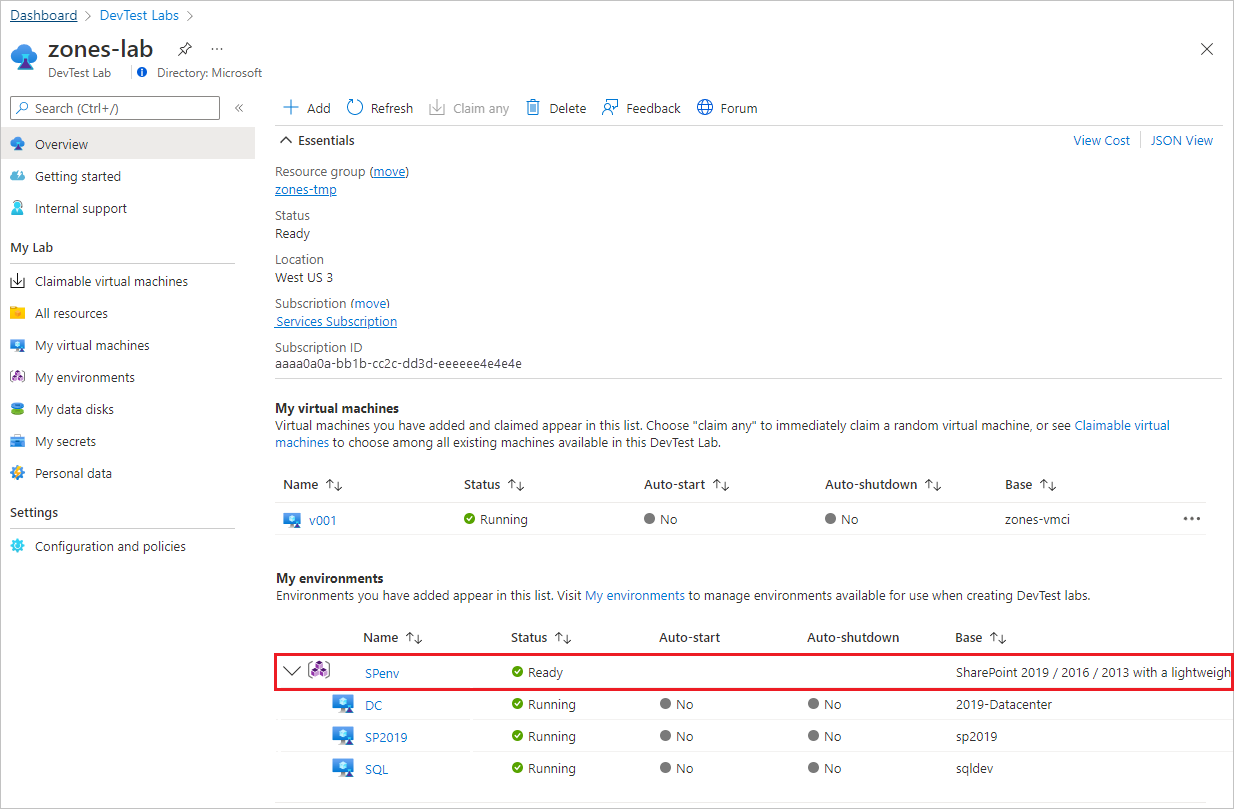Note
Access to this page requires authorization. You can try signing in or changing directories.
Access to this page requires authorization. You can try changing directories.
This article describes platform-as-a-service (PaaS) support in Azure DevTest Labs. DevTest Labs supports PaaS through environments, which can include both PaaS and infrastructure-as-a-service (IaaS) resources. Environments contain services and software like virtual machines (VMs), databases, virtual networks, and web apps that are customized to work together.
The following image shows a SharePoint farm created as an environment in a lab.

Note
Azure Deployment Environments (ADE) is highly recommended for creating environments. ADE empowers developers to rapidly deploy app infrastructure using project-based templates, ensuring consistent and secure environments for your development teams.
To learn more about Azure Deployment Environments, see Azure Deployment Environments documentation.
PaaS scenarios
DevTest Labs PaaS environments support the following scenarios:
- Developers can create multiple, independent environments.
- Testers can test different configurations asynchronously and automatically.
- Staging and production pipeline integration can happen without any template changes.
- Lab owners can configure policies and track costs for the environment as a whole.
Developer scenarios
To create an environment, a developer selects an environment template rather than a machine image, and enters any required information. Individual developer environments allow faster change deployment and improved inner loop debugging. Developers can destroy their environments anytime, and recreate them by using the latest templates. This capability helps reduce downtime from creating systems manually or recovering from faults.
Test scenarios
DevTest Labs environments allow independent, asynchronous testing of specific code and configurations. Testers can use continuous integration and continuous deployment (CI/CD) pipelines to set up environments, apply code from individual pull requests, and do automated and manual testing. Automation can manage and track multiple environments across subscriptions and labs.
Cost tracking
The overall cost trend for a lab includes Azure resources within environments. The cost by resources doesn't break out the different resources within an environment, but displays the environment as a single cost. For more information, see Track costs associated with a lab in Azure DevTest Labs.
Access and roles
Lab owners can grant lab access and assign user roles. For more information, see Add lab owners, contributors, and users in Azure DevTest Labs.
The DevTest Labs resource provider creates resources on the lab user's behalf, so lab users don't need any extra permissions to create and use environments. However, lab owners can extend Contributor permissions to lab users so they can configure and manage their own PaaS resources, such as adding or removing resources. For more information, see Configure environment user rights.
Lab owners can customize resource access or permissions without granting subscription-level access. The lab user can add or remove Azure resources only within the managed resource group. To further customize lab user roles and access, see Grant user permissions to specific lab policies.
Environment templates
DevTest Labs creates environments by using preconfigured Azure Resource Manager (ARM) templates from Git repositories. Keeping the ARM templates under source control promotes consistent environment deployment and management.
In large organizations, development teams typically provide customized or isolated testing environments. The IT group provides environments that all teams within a business unit or a division can use.
To enable and configure environment creation for labs, see Use ARM templates to create DevTest Labs environments. DevTest Labs has a public repository of preconfigured ARM templates for creating certain environments. For more information about the public environments, see Enable and configure public environments.
You can also create or configure your own ARM templates, store them in private Git repositories, and connect those repositories to labs.
Template customization
You can provide certain custom lab information in ARM templates when creating environments, including:
- Lab virtual network identification
- Lab location
- Lab storage account where the ARM templates files are copied
Use an existing virtual network
When you create an environment, DevTest Labs can replace the $(LabSubnetId) token with the first lab subnet where Use in virtual machine creation is set to true. This modification allows the environment to use previously created virtual networks.
Connect environments to the lab's virtual network describes how to modify an ARM template to use the $(LabSubnetId) token. To use the same ARM template in test, staging, and production environments, use $(LabSubnetId) as a value in an ARM template parameter.
Use nested templates
DevTest Labs supports nested ARM templates. To use _artifactsLocation and _artifactsLocationSasToken tokens to create a URI to a nested ARM template, see Deploy DevTest Labs environments by using nested templates. For more information, see the Deployment artifacts section of the Azure Resource Manager Best Practices Guide.